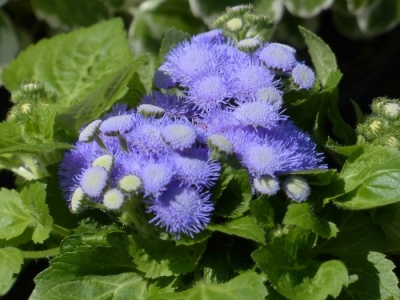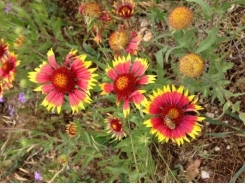How to Grow Ageratum (Floss Flower)

True blue. There are few flowers out there that can claim that title. Ageratum (pronounced AH-jer-a-tum) is one of them, though.
In addition to that perfect blue, ageratums can be pink, white or purple, too. Their soft and fluffy flower heads gives this flower a whimsical character. Ageratum is also referred to as floss flower. It has been a favorite in gardens for generations.
Ageratum (Ageratum houstonianum) is a fast-growing annual in most regions, which makes it a charming fill in for flower beds and borders. It is a great annual for container gardens, too. And in U.S. Department of Agriculture zones 10 and 11, you can enjoy this flower as a perennial.
Unlike most annuals, ageratum craves heat as it is developing. Once it is mature, it will tolerate the cold more readily, but still prefers to be toasty as opposed to other cool-loving annuals that wilt with heat. Ageratums originated in Central and South America, so its inclination to temperate conditions is a distinctive part of its nature.
How to Grow and Care for Ageratum
Start your ageratum seeds indoors 6 to 8 weeks before your last frost. Once all danger of frost has passed, take your baby plants outside. Transplant them in a sunny location. Remember, this plant loves to be warm. It will develop slowly unless given plenty of rays from the sun.
If you are using your ageratum as a bedding plant, space your plants about 8 inches apart. As the transplants grow, they will fill in quickly. Taller varieties can be spaced further apart.
Ageratum isn't very choosy about soil conditions, but it won't do well with soggy feet. Make sure your soil drains well. And don't let the soil dry out either. Ageratums quickly wilt if conditions are too dry. Because it prefers warmth over cold so much, some suggest watering an ageratum with warm water as opposed to cold. Especially when the plants are young, warm water seems to speed up the growth process of this plant.
If you would prefer not to start from seed, your local nursery will probably have a transplant for you. You will enjoy the blooms of your ageratum in no time when you transplant after the danger of frost has passed.
You can expect your ageratum to bloom happily from mid-summer to that first frost of fall. And it should attract the attention of hummingbirds and butterflies for you wildlife lovers out there.
Ageratum Pests and Problems
Ageratum is generally hardy when cared for properly. There are a few pests to look out for, though. The largest-sized pest for ageratum is deer. If your plant disappears overnight, a deer is probably the culprit.
Whiteflies may weaken your plant, causing the leaves to yellow. The flies can be lured away from your ageratum with an old- fashioned fly trap. Paint a post bright yellow and cover it with honey or some other sticky substance.
If you notice your ageratum leaves are severely yellowed, wilted, and dying, or if there are lesions on the stems, your plant has probably succumbed to a bacterial infection. The unhealthy plant should be removed to avoid spread of the disease to neighboring ageratums.
You may find brown spots on the leaves or mold on the stems and flowers of your ageratum. The plant will probably survive this problem through the season. However, you may try thinning your plants to allow more air flow around the plant. Sunlight will keep the leaves and flowers drier, too, which will help deter molds from further damaging your plant.
Cultivars to Consider
With as many choices as there are, your biggest problem with your ageratum may simply be choosing just one or two of these pretty varieties. Here are a couple we thought were worth mentioning.
'Tall Blaze Horizon' is a tall version of the more traditional bedding plant. The blazing blue color is a striking contrast to reds and yellows in the garden. This is a great variety for cutting.
'Southern Cross' is one of a few ageratum that produce two colors in the petals. Southern Cross is white in the center and fades to a soft blue around the edges.
Related news
Tools

Phối trộn thức ăn chăn nuôi

Pha dung dịch thủy canh

Định mức cho tôm ăn

Phối trộn phân bón NPK

Xác định tỷ lệ tôm sống

Chuyển đổi đơn vị phân bón

Xác định công suất sục khí

Chuyển đổi đơn vị tôm

Tính diện tích nhà kính

Tính thể tích ao



 How to Get Rid of Invasive Mugwort
How to Get Rid of Invasive Mugwort  How to Grow Statice
How to Grow Statice